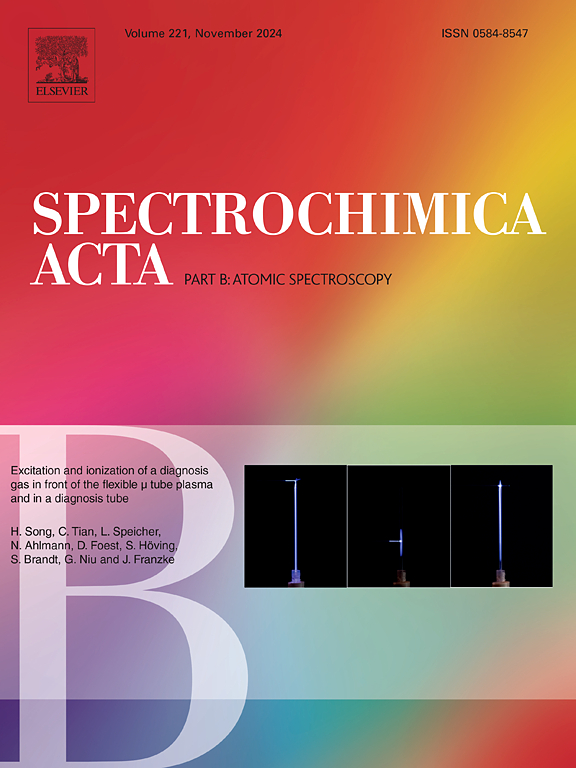Isotopic analysis of liquid lithium via laser-produced vapor for laser-induced breakdown spectroscopy
IF 3.2
2区 化学
Q1 SPECTROSCOPY
引用次数: 0
Abstract
To realize fusion energy in the near future, tritium self-sufficiency is an essential technology in the deuterium-tritium (2H![]() 3H) fuel cycle. Thus, high 6‑lithium (6Li) isotope enrichment is desirable to improve the performance of the fusion plant. Additionally, a fast and reliable analysis method for measuring the abundance of Li isotopes is also essential. A novel isotope analysis technique for liquid Li samples, called laser-produced vapor for laser-induced breakdown spectroscopy (LPV-LIBS), has been developed and introduced to measure isotopic abundance. The LPV-LIBS technique combines LPV, in which elements in the liquid samples are vaporized by a high-power pulse laser, and LIBS, in which the laser-induced plasmas are analyzed through optical emission spectroscopy. Li spectra of the 2 s-2p transition line were measured and analyzed, and the results were consistent with those of the reference samples of liquid LiCl employing the developed LPV-LIBS. This is a promising simple and rapid method for measuring the Li isotopic abundance in fusion applications and for other industrial needs.
3H) fuel cycle. Thus, high 6‑lithium (6Li) isotope enrichment is desirable to improve the performance of the fusion plant. Additionally, a fast and reliable analysis method for measuring the abundance of Li isotopes is also essential. A novel isotope analysis technique for liquid Li samples, called laser-produced vapor for laser-induced breakdown spectroscopy (LPV-LIBS), has been developed and introduced to measure isotopic abundance. The LPV-LIBS technique combines LPV, in which elements in the liquid samples are vaporized by a high-power pulse laser, and LIBS, in which the laser-induced plasmas are analyzed through optical emission spectroscopy. Li spectra of the 2 s-2p transition line were measured and analyzed, and the results were consistent with those of the reference samples of liquid LiCl employing the developed LPV-LIBS. This is a promising simple and rapid method for measuring the Li isotopic abundance in fusion applications and for other industrial needs.

求助全文
约1分钟内获得全文
求助全文
来源期刊
CiteScore
6.10
自引率
12.10%
发文量
173
审稿时长
81 days
期刊介绍:
Spectrochimica Acta Part B: Atomic Spectroscopy, is intended for the rapid publication of both original work and reviews in the following fields:
Atomic Emission (AES), Atomic Absorption (AAS) and Atomic Fluorescence (AFS) spectroscopy;
Mass Spectrometry (MS) for inorganic analysis covering Spark Source (SS-MS), Inductively Coupled Plasma (ICP-MS), Glow Discharge (GD-MS), and Secondary Ion Mass Spectrometry (SIMS).
Laser induced atomic spectroscopy for inorganic analysis, including non-linear optical laser spectroscopy, covering Laser Enhanced Ionization (LEI), Laser Induced Fluorescence (LIF), Resonance Ionization Spectroscopy (RIS) and Resonance Ionization Mass Spectrometry (RIMS); Laser Induced Breakdown Spectroscopy (LIBS); Cavity Ringdown Spectroscopy (CRDS), Laser Ablation Inductively Coupled Plasma Atomic Emission Spectroscopy (LA-ICP-AES) and Laser Ablation Inductively Coupled Plasma Mass Spectrometry (LA-ICP-MS).
X-ray spectrometry, X-ray Optics and Microanalysis, including X-ray fluorescence spectrometry (XRF) and related techniques, in particular Total-reflection X-ray Fluorescence Spectrometry (TXRF), and Synchrotron Radiation-excited Total reflection XRF (SR-TXRF).
Manuscripts dealing with (i) fundamentals, (ii) methodology development, (iii)instrumentation, and (iv) applications, can be submitted for publication.

 求助内容:
求助内容: 应助结果提醒方式:
应助结果提醒方式:


